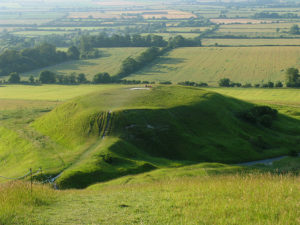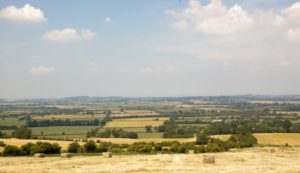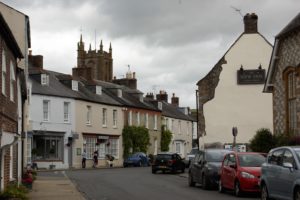In south-west England, large swaths of chalkstone lie under the soil. For millenia, people have cut out large figures by digging trenches to reveal the underlying chalk. The chalk contrasts with the surrounding grass, which makes the figures stand out. Because they’re cut into the hillsides, these figures are difficult to see from the ground, and are best viewed from very far away or even from the air.
These geoglyphs are thought be ancient. However, they do benefit from regular maintenance. Every now and then, a large work party assembles at the site to cut the grass around the figure and re-chalk it if necessary.
The oldest figure is believed to be the Uffington White Horse, which is located near Ashbury, Oxfordshire. It’s a highly stylized depiction of a horse that is similar to those found in Celtic drawings. It’s thought to be about 3000 years old. Possibly it’s a tribal symbol created by the occupants of the Iron Age fort located above it to frighten off their enemies.
When silt deposits taken from the horse’s snout were analyzed, archaeologists dated the figure to the late Bronze Age (1000-700 BC). Coins from this period have been found with this image on it, which also supports its age.
My attempt to photograph it wasn’t very successful, so this is what it looks like from the air (thank you, National Trust):

The hill immediately below the horse is called Dragon Hill. This is said to be the spot where St. George slayed the dragon. If you see the flat hill as the dragon’s back then the smaller hill in the foreground might be his head, slumped on the ground. I got it, but Julian was mystified.

The view from White Horse Hill was pretty amazing, too.

The pretty village of Cerne Abbas in Dorset also has a chalk figure. Cerne Abbas is more than 1100 years old. The village, which is mentioned in the Domesday Book, sprang up around an abbey founded here in the 10th century.

The figure is one of a man with an enormous erect penis, wielding a club. It has been described variously as a Celtic warrior, a Saxon god or a Roman depiction of Hercules. Originally, it was believed to be ancient. However, archaeologists now suspect it is only 400 years old because there is no mention of it in contemporaneous descriptions until the mid-1600s.

The most likely theory is that it is a satirical depiction of Oliver Cromwell, who was mocked as “England’s Hercules” by his political opponents. The National Trust sign at the site blames the monks who were allegedly protesting the closure of their abbey. However, that closure had occurred more than 100 years earlier than the figure was created. And the abbey was closed because of the abbot’s corruption, not because of politics.
The most likely culprit is Lord Denzil Holles, who lived at Cerne Abbas, and who hated Cromwell.
Lords can create tribal symbols too.




Comments
I can understand why Julian was mystified. It doesn’t look the least bit like a dragon – just a hill with a bump.
Author
Hey, Fred, is that Julian?